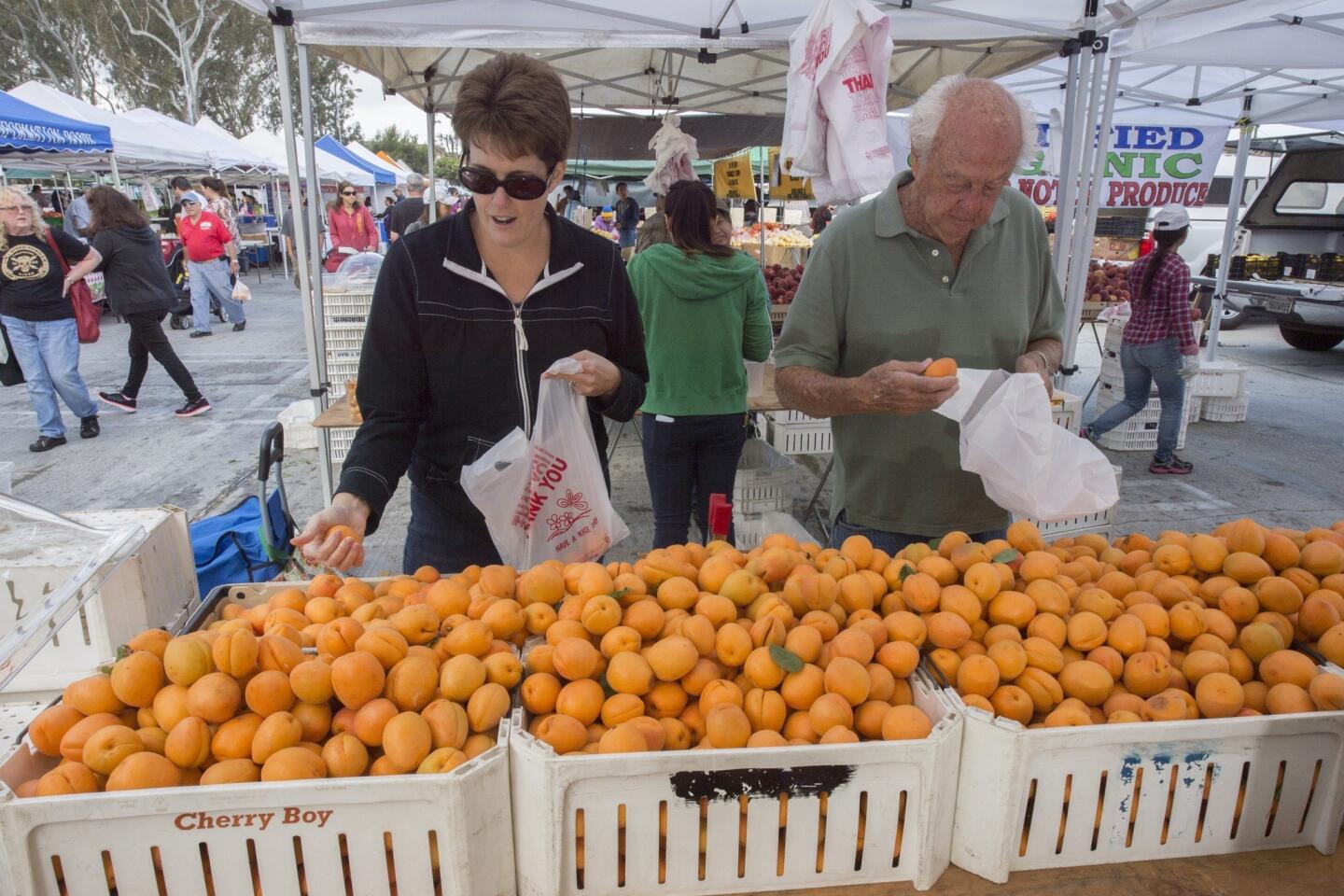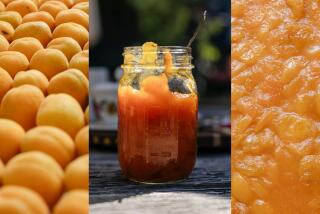Farmers Markets: It’s prime time for apricots
- Share via
After a month of mediocre early-season apricots, the prime varieties, sweet, juicy and flavorful, are here or will be soon. Beyond the celebrated Blenheim, there are other worthwhile varieties, and a few are even better. Here are the leading apricots and apricot-like hybrids, in order of ripening, rated on a scale of 1 to 10 for flavor. The crop is about a week early this year and looks good in size and quality.
• Apache (5 rating). Season typically May 5-25. Introduced by Ledbetter, USDA, 2002; has Royal and Perfection in its pedigree. Medium size, bright orange skin, deep orange; fairly juicy flesh, has a good sweet-tart balance and some aroma when ripe, so flavor is good for its very early season. Available from Scott Arnett, Frog Hollow (Al Courchesne), Fair Hills (David Rydell), Harry Nicholas.
• Poppy (3). May 5-30. Zaiger, 1996; parentage includes Earlicot and Spring Giant apricots. Medium in size, but large for the early season, with light yellow to pale orange skin, and a flavor that can charitably be termed mild; widely grown for the early season fresh market. From Troy Regier, Arnett, Mark Boujikian, Gerardo Gama, Truman Kennedy, Arnulfo Garcia, Fruit Fairy (Deborah Qualls), Island Farms (Alan Asdoorian).
• Tasty Rich Aprium (4). May 5-30. Zaiger, 2001; 11/16 apricot, 5/16 plum. Medium size, oblong with compressed cheeks, pale orange skin, lightly blushed, with light fuzz; yellow-orange flesh with somewhat acidic, mediocre flavor, maybe a slight improvement over Earlicot and Poppy, the most prevalent apricots at its time. Tastes like an apricot and is often marketed as one. From Jay Scott, Ken Lee, Boujikian, Arnett, Richard Burkart, Sweet Tree Farms (Annie Florendo).
• Earlicot (3). May 10 to June 5. Zaiger, 1990; parentage includes Flaming Gold and Perfection apricots. Large for season, round, pale orange with occasional blush, with bland flavor; widely grown for the early season fresh market. Packinghouse culls of this variety are sometimes illicitly sold at farmers markets. From Gene Etheridge, Rancho Padre (Robert Todd), John Tenerelli, Truman Kennedy.
• Castlebrite (3). May 15 to June 5. J.H. Weinberger, USDA, 1971; open-pollinated seedling of (Perfection x Castleton). Medium size, orange skin with some red blush and speckling; tart and tasteless unless dead-ripe, and never very good. Long a leading fresh-market variety because it is attractive and productive, and can take the heat of the San Joaquin Valley without developing pit burn; a poster child for specious commercial fruit. From Arnett, Regier, Boujikian.
• Nicole (7). May 15 to June 5. Ledbetter, USDA, 2003; has Orangered, Perfection and Royal in its pedigree. Medium size, bright orange skin with strong blush; flesh luscious, high in sweetness, acidity and aroma when ripe; almost as good as a Blenheim, but a month earlier. Described by its breeder as “an early season industrial apricot for the processing market,” because it cracks when ripe, and makes fine preserves; but this variety would be a revelation at farmers markets, if only it were available.
• Honey Rich Aprium (4.5). May 20 to June 10. Zaiger, 1997; hybrid of apricot and plum, primarily apricot. Parents include Tom Cot and Flaming Gold apricots and Red Beaut plum. Looks like an apricot with lighter fuzz, glossier skin; flavor is mediocre, but a definite improvement on Castlebrite. From Steve Murray, Ken Lee, Burkart, Arnett, Sweet Tree.
• Ume Japanese apricot, Prunus mume (1 for eating fresh; excellent for processing). May 20-June 10. Small, round; greenish yellow skin, with greenish yellow, firm, dry, sour flesh; too acid for eating fresh, usually processed as pickles (ume-boshi) or liquor. Native to China, ume trees are treasured for their fragrant blossoms in Japan, where the fruits are considered plums. From K&K Ranch (Stan and June Kashima).
• Lorna (5). May 20 to June 10. Ledbetter, USDA, 1998. Large, oval; solid orange skin, firm flesh with decent flavor when fully ripe, but not particularly aromatic. From Eileen Pritchett, Honey Crisp (Ron Cornelsen/Art Lange), Boujikian.
• Flavorella plumcot (7). May 25 to June 10. Zaiger, 1992. Red Beaut plum x unknown apricot. Bright canary yellow when ripe, with powerful acidity and sweetness, intense Santa Rosa plum aroma; clingstone. The most flavorful stone fruit in its season, but difficult for farmers to grow, because its pollination is problematic, and the slightest wind will blow the fruits off the trees. Light yellow fruit, even slightly tinged with green, will ripen nicely in a day or two; dark yellow fruit is ideal, of course, but must be eaten quickly, before it starts to ferment. From Fitzgerald Kelly, Honey Crisp, Arnett, Arnulfo Garcia.
• Katy (5). May 25 to June 15. Zaiger, 1977; second-generation seedling of Flaming Gold. Medium size, round, light orange skin with light orange-red blush, moderately juicy and sweet; when over-mature it loses acidity and becomes bland. One of the first low-chill varieties, popular in home gardens. From Honey Crisp, K & K (Kashima), Island Farms (Alan Asdoorian).
• Robada (7). May 25 (Fresno) to June 20 (high desert). Ledbetter, USDA, 1997; Orangered X K11340 (ancestry includes Blenheim, Blush and Perfection). Large, oblong with compressed cheeks, with red blush over deep orange skin; firm and meaty, juicy when fully ripe; has rich, sweet-tart flavor, like apricot jam; the best publicly available commercial apricot that can be grown in the San Joaquin Valley. From Tenerelli, Frog Hollow, Honey Crisp, Fitzgerald Kelly, Arnett.
• Helena (5). June 1-20. Ledbetter, USDA, 1994. Very large size, deep orange skin, with firm, fairly sweet and juicy flesh, but not particularly aromatic. From Arnett, Sweet Tree, Boujikian.
• Newcastle (6). June 1-15. C.M. Silva, Newcastle, Placer County, 1881. Small to medium, round, speckled, like a paler version of Royal, similar but not quite as rich in flavor; very delicate and perishable. Among the earliest of old-fashioned apricots. From Mud Creek Ranch (Steve and Robin Smith).
• Cot-N-Candy Aprium (6). June 5-25. Zaiger, 2005; from Tri-Gems and Modesto apricots, Friar plum and Splash plumcot. Yellowish-white skin and flesh, juicy and sweet, with a melony flavor; delicate, bruises easily; the closest thing to a white apricot available at farmers markets, but not as complex and intense as elite noncommercial varieties. From Frog Hollow (June 5 this year), Nicholas Family Farms.
• Goldensweet (6). June 10-30. Bradford, 1994. Medium size, light orange skin; low in acidity, moderately aromatic; one of the better varieties from the San Joaquin Valley, a step up from Patterson. From Linda Apkarian, Tenerelli, Frog Hollow (June 5), Arnett, Harry Nicholas, Etheridge.
• Patterson (4.5). June 10 to July 5. Fred Anderson, 1968; grandchild of Perfection. Medium size, oblong with compressed cheeks; orange skin, rarely blushed; firm, rubbery flesh, only moderately sweet and aromatic. The leading variety in the San Joaquin Valley because it is highly productive, grows cleanly and doesn’t pit-burn in the area’s heat; originally released for canning but also used for drying and fresh market. Not terrible, but there are better choices in its season. From Regier, Arnett, Pritchett, Burkart, Avila, Island Farms, Boujikian.
• Blenheim / Royal (8 and occasionally 9 from coastal valleys; 6 from San Joaquin Valley). June 10 to July 15. Blenheim Palace, England, 1830; seedling. Small, roundish oval, a little flattened on each side, often freckled; sweet, tender flesh with rich, honeyed apricot flavor, the standard of quality in California; prized for its aroma, which is concentrated in dried fruit. Fragile, ripens from inside out; fruit from coastal valleys outshines specimens from the San Joaquin Valley, where its delicate insides turn to mush (pit burn). In the late 19th century Royal and Blenheim were grown as distinct varieties, but by 1920 they were sold indiscriminately by many California nurseries, and today many farmers call them both Royal Blenheim. Blenheim is a bit larger and has a rounder stone, while the Royal is slightly flattened, almost wedge-shaped. From Michael Cirone (June 19 this year), Forcefield (Eric and Helle Todd), Flora Bella Farm (James Birch, June 9); K.B. Hall Ranch, Ojai.
• Anya (10) and Yuliya (9) (sold as CandyCots). June 15 to July 15. John Driver, Waterford, 2001; derived from seeds brought from Central Asia, the apricot’s homeland. Incredibly sweet and intense, an apricot lover’s dream. There are 100 acres now bearing. From Frog Hollow at Santa Monica Wednesday farmers market, probably June 12 (Anya) and June 19 (Yuliya). Also at Whole Foods and Vons.
• Brittany Gold (5). June 20 to July 15. Zaiger, 2002; pedigree includes Tri Gem, Modesto and King apricots. Medium size, round, slightly flattened at top and bottom; orange skin with little blush; firm flesh, moderately juicy, with good sweet-tart balance but little aroma. From Burkart, Arnett, Avila, Murray.
• Tilton (5). June 25 to July 10. J.E. Tilton, Hanford, 1885; chance seedling. Large for an older variety; widely planted in the early and mid 20th century in the San Joaquin Valley because it was one of the few varieties that did not pit-burn there, used for fresh shipping and drying. The flavor is pleasant but mild; the texture can be juicy or dry, but is often somewhat mealy, and Tilton is rarely planted today. From Truman Kennedy, Rancho Padre, K&K (Kashima).
• Moorpark (9). July 1-15. Moor Park, Hertfordshire, England, 1760; possibly a seedling of Peach apricot. Large and round, with orange skin marked with numerous deep red specks, and luscious, bright orange flesh with a rich, greengage-like flavor. The finest of traditional apricots, but even in the Santa Clara Valley, where it is best adapted, it bears irregularly and ripens unevenly. Alameda Hemskirke, a similar, equally fine variety, is distinguished from Moorpark by its unperforated stone; Moorparks at Southern California markets are often Wenatchee Moorpark, a different and inferior variety. From Honey Crisp at farmers markets; and in its proper terroir, Giordano Farms, San Jose; Andy’s Orchard, Morgan Hill.
More to Read
Eat your way across L.A.
Get our weekly Tasting Notes newsletter for reviews, news and more.
You may occasionally receive promotional content from the Los Angeles Times.











